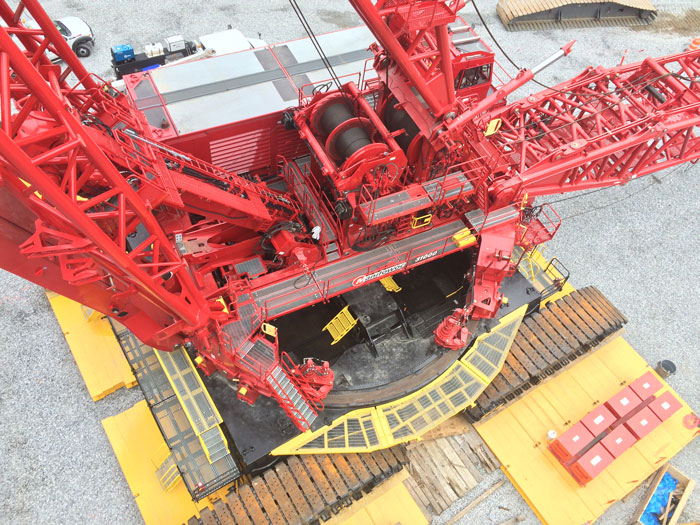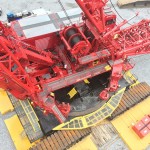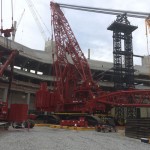Post Assembly Crane Inspections
Post-assembly crane inspections happen on jobs across the country every day, but, it’s not every day that the cranes include enormous, limited edition machines. Crane Industry Services was called on by Maxim Crane Works in 2015 to deliver a third-party, post-assembly crane inspection of their Manitowoc 31000, of which there are only two in the world, and by Derr & Isbell Construction for two Liebherr LR 11000s configured with the PowerBoom (P-Boom).
Working on the Mercedes Benz Stadium in Atlanta, Ga., all three cranes are making history. This is the first time the 31000 and the 11000s with the P-Boom configuration have worked on a project in North America. The stadium, which will be the home of the NFL Atlanta Falcons beginning in 2017, features a retractable roof design that opens and closes like the lens of a camera.
The Manitowoc 31000, owned by Maxim Crane Works, features a 2,535-ton capacity and the Variable Position Counterweight (VPC) system. According to an article published about the job in the November 2015 issue of American Cranes and Transport (ACT) magazine, the crane was delivered in 127 loads plus 24 additional loads of custom-designed steel crane mats. “Almost all of the loads were permitted, overweight loads,” said Barry Garrett, Maxim’s Project Manager.
The 1200-ton Liebherr LR 11000 was first introduced to the U.S. market at ConExpo in 2014. Buckner Heavylift Cranes owns the two that are working on the stadium project. The model features a large number of boom versions. Standard components comprising the S main boom and W luffing jib enables the crane to achieve various boom configurations, including a strong P-Boom system with a heavy luffing jib. The PowerBoom improves stability in the direction of the load and to the side, which results in enormous increases in lifting capacity with long boom systems.
Inspection Experts
“OSHA requires that cranes be inspected any time the configuration changes, initially or during the project, such as when adding boom sections or jibs,” explains Cliff Dickinson, President of Crane Industry Services (CIS). “Although third-party inspections are not required by OSHA, it is a common requirement of the General Contractor. These inspections offer the crane owner and general contractor certain benefits. “An independent verification can be more objective and provides peace of mind that the assembly is done according to the manufacturer’s instruction,” said Dickinson.
During a post assembly crane inspection, CIS inspectors will talk to the A/D Director about the assembly procedures and compare the actual configuration to drawings and specifications provided by the manufacturer. Regardless of the crane size or make, post-assembly inspections also include verifying the accuracy of the Load Moment Indicator system using a known weight, verifying that boom hoist and luffer upper limits are set correctly for the configuration, confirming that boom sections are in the right order for the configuration, as well as inspecting the pins, keepers, and rope reeving.
“In many situations, we will also look at lift plans and observe a dry-run of the crane moved into position with the hook block dropped to the expected load pick location,” said Dickinson.
Coordinated Assembly
Inspection of cranes like the Manitowoc 31000 or the Liebherr LR 11000 with P-Boom is different than just conducting a standard inspection on a larger scale. “Pictures don’t do these cranes justice,” said Dickinson. Consider that the LR 11000’s load block weighs about 47,000 pounds. “That’s greater than the capacity of many cranes,” said Dickinson. The 31000’s load block weighs about 80,000 pounds and featured 28 parts of 2-inch wire rope.
“I’m about six feet tall. I was dwarfed by the height of one of the 31000’s four crawler tracks as I stood next to it,” he said. For comparison purposes, the Manitowoc 2250s are assembled in two days and a post-assembly inspection can usually be conducted on a single trip. CIS also conducted post-assembly inspections of half a dozen 2250s on this project.
However, it took 28 days to assemble the Manitowoc 31000. “This particular erection was complicated by getting trucks in and out of a crowded jobsite and working around multiple other crawler cranes inside the bowl of the football stadium,” said Alan Ashlock, Southeast Region President for Maxim Crane, reported ACT.
“We had to coordinate with the A/D Director to conduct the inspection in stages. As parts are assembled, it’s necessary to inspect them while they’re on the ground because once the component is raised, it may not be accessible even with using an aerial work platform,” said Dickinson. In all it took seven separate trips for Crane Industry Services to inspect the Manitowoc 31000. “It took multiple trips to inspect the Liebherr cranes also,” said Dickinson.
Although the CIS inspection team has years of experience, “We don’t pretend to know it all. We ask lots of questions and use resources such as the manufacturers’ engineers. For the assembly of these unique cranes, all hands were on deck,” said Dickinson, including manufacturer representatives and a crane operator who spent weeks training specifically on the 31000.
“I remember working with a crew erecting a Manitowoc 4100 Ringer on a bridge job in the 1970s. As the Ringer components arrived, we unloaded 17 trailers for this crane. I wondered if something was wrong because some of the pieces were bent,” laughed Dickinson, referring to the Ringer component. “At the time, it was the biggest crane I’d ever seen. Today, crane designs are evolving at a more rapid pace, challenging the industry to keep up,” said Dickinson.
Tips for hiring a third-party crane inspector
- Has craft experience assembling and disassembling cranes
- Has experience working with crane A/D directors
- Has crane operation experience
- Is familiar with a wide variety of crane makes and models
- Is familiar with NDT inspection procedures
- Has achieved a recognized certification or assessment as a crane inspector





